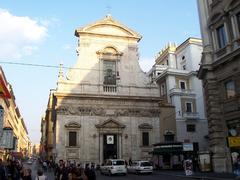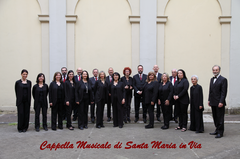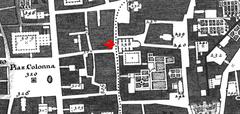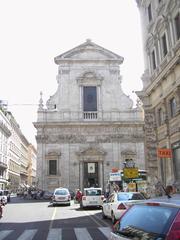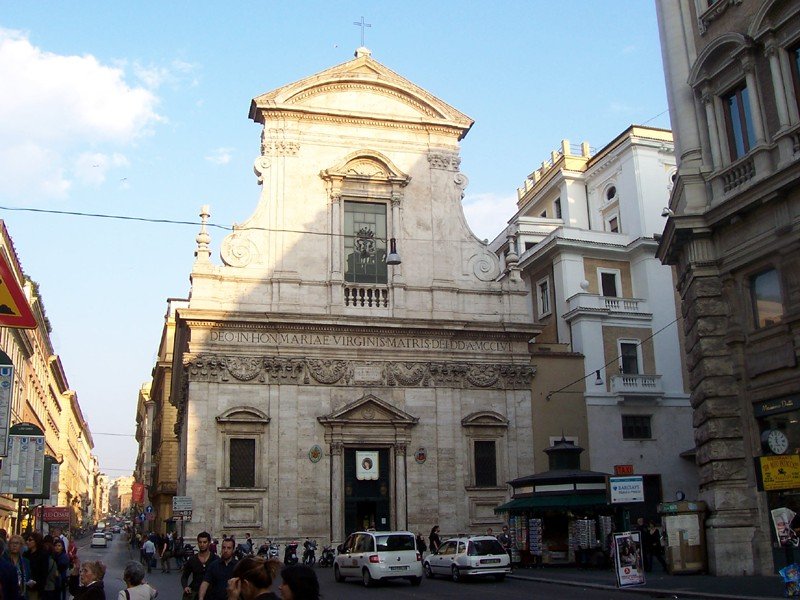
Santa Maria in Via Rome: Visiting Hours, Tickets & Historical Sites Guide
Date: 14/06/2025
Introduction
Santa Maria in Via, set in the vibrant heart of Rome, is a remarkable testament to the city’s centuries-old religious heritage and its evolving architectural landscape. Just steps from the Trevi Fountain and situated along the historic Via Flaminia, this church captivates visitors with its unique blend of history, art, and spirituality. Renowned for a miraculous event in 1256 involving a Marian image found floating in a well, Santa Maria in Via has inspired deep devotion and continues to serve as a spiritual home for locals and pilgrims (Wikipedia; Rome City Now).
The church is not only celebrated for this miracle but also for its ties to apostolic tradition—its crypts are believed to have sheltered the Apostles Peter and Paul during their time in Rome, making it a significant site for Christian pilgrimage, especially during Jubilee years (Italia.it; EWTN Vatican). Architecturally, Santa Maria in Via combines Renaissance foundations with Baroque flourishes, most notably the façade by Pietro da Cortona and richly decorated interiors that reflect the fervor of the Counter-Reformation (Planned to Where).
This guide provides comprehensive information on Santa Maria in Via’s history, art, visitor details, and practical travel tips, ensuring you make the most of your visit to this Roman gem.
Table of Contents
- Early Origins and Medieval Foundations
- The Miracle of 1256 and Papal Recognition
- Renaissance and Baroque Developments
- Artistic and Architectural Highlights
- Apostolic Tradition and Pilgrimage
- Community and Cultural Role
- Visitor Information: Hours, Tickets & Accessibility
- Guided Tours and Visitor Tips
- Nearby Attractions & Travel Suggestions
- Frequently Asked Questions (FAQ)
- Conclusion and Further Resources
Early Origins and Medieval Foundations
Santa Maria in Via’s origins date back to at least the 9th century, when a chapel or small church stood on the site to serve the local Christian community (Wikipedia). The name “in Via” refers to its proximity to the ancient Via Flaminia, a major Roman road pivotal to the city’s development (Rome City Now). By the 12th century, the church was well-established as a spiritual waypoint for travelers and pilgrims entering Rome.
The Miracle of 1256 and Papal Recognition
A defining moment in the church’s history occurred on September 26, 1256. According to tradition, an image of the Virgin Mary was found floating atop the water in a well after a sudden flood in the stables of Cardinal Pietro Capocci’s house, located on the current church site. Once the image was retrieved, the waters receded—an event quickly interpreted as miraculous (Wikipedia). Pope Alexander IV responded by commissioning a chapel to house the image and preserve the site of the miracle, which is still visible in the first chapel on the right (Rome City Now).
Renaissance and Baroque Developments
The church underwent significant transformation during the Renaissance. Pope Innocent VIII ordered the construction of a new church in 1491, completed in 1513. The Servite Order was entrusted with its care by Pope Leo X, a stewardship that continues (Wikipedia).
In the 17th century, the façade and portico were redesigned by Baroque master Pietro da Cortona, whose dynamic forms and rich ornamentation embody the era’s artistic exuberance. The main altar was embellished by Santi Ghetti, and the church was consecrated in 1604 under Cardinal Robert Bellarmine (Wikipedia).
Artistic and Architectural Highlights
Santa Maria in Via harmoniously fuses Renaissance and Baroque styles. The single-nave interior, flanked by side chapels, features a barrel-vaulted ceiling and marble floors with geometric patterns. The Chapel of the Miraculous Well is richly decorated with marble, stucco, and frescoes, and houses the venerated Marian image (Planned to Where). Notable artworks by Francesco Salviati and Giacomo della Porta, along with elaborate frescoes and stuccoed ceilings, provide a visual feast for visitors.
Restoration efforts ahead of the 2025 Jubilee have ensured the preservation of the façade, chapel, and interior artworks (Italy Perfect).
Apostolic Tradition and Pilgrimage
A unique aspect of Santa Maria in Via is its association with the Apostles Peter and Paul. Tradition holds that the crypts beneath the church served as a refuge for the apostles during their time in Rome (Italia.it; EWTN Vatican). The crypt features Baroque bas-reliefs of the apostles and is accessible via guided tours, offering a contemplative space that connects visitors with the city’s earliest Christian history.
The church’s role as a pilgrimage stop is emphasized during Jubilee Years, when Rome welcomes millions seeking to connect with its apostolic roots. Santa Maria in Via participates in special liturgies, processions, and extended hours during these holy periods.
Community and Cultural Role
Santa Maria in Via’s status as a national church for the Ecuadorian community in Rome highlights its ongoing role as a center for diverse worship, cultural events, and social outreach (Rome City Now). The Servite Order maintains a schedule of Masses, Marian feasts, and charitable activities, continuing the church’s original mission of service and hospitality.
Visitor Information: Hours, Tickets & Accessibility
- Opening Hours: Generally, the church is open Monday to Saturday from 7:00 AM–12:30 PM and 4:00 PM–7:00 PM; Sundays, 8:00 AM–1:00 PM. Hours may vary during holidays (Official Santa Maria in Via Website).
- Entrance: Free to the main church. Guided tours of the crypt and underground areas require a ticket, typically €8–€12 (Florence Tickets).
- Accessibility: The main church is wheelchair accessible. Underground areas involve stairs and are not fully accessible.
- Dress Code: Modest attire required (shoulders and knees covered).
- Photography: Allowed without flash in the main church; restrictions may apply in the crypt.
Guided Tours and Visitor Tips
- Guided tours (onsite and online) are available and recommended for a deeper understanding of the church’s art, history, and crypt. Advance booking is advisable, especially during Jubilee seasons (Florence Tickets).
- Consider using audio guides such as the Audiala app for self-guided exploration.
- Visit early or late in the day to avoid crowds.
- Respect the sacred environment by maintaining silence, especially during services and in the crypt.
Nearby Attractions & Travel Suggestions
Santa Maria in Via’s central location allows for convenient exploration of Rome’s historical sites:
- Trevi Fountain: Just 50 meters away.
- Piazza di Spagna & Spanish Steps: A 10-minute walk.
- Via del Corso: A major shopping and historical street.
- Pantheon and Piazza Venezia: Easily reached on foot.
Combine your visit with a stroll through the Trevi district for an authentic Roman experience.
Frequently Asked Questions (FAQ)
Q: What are the church’s visiting hours?
A: Typically, Monday–Saturday 7:00 AM–12:30 PM and 4:00 PM–7:00 PM; Sunday 8:00 AM–1:00 PM. Check the official website for special schedules.
Q: Is there an entrance fee?
A: Entry is free; tickets are required for underground tours.
Q: Are guided tours available?
A: Yes, both onsite and online—book in advance during busy seasons.
Q: Is the church accessible for visitors with disabilities?
A: The main church is wheelchair accessible; underground areas are not fully accessible.
Q: Can I take photographs?
A: Yes, but without flash in main church; restrictions may apply in the crypt.
Q: What is the significance of the well?
A: It is the site of the 1256 Marian miracle and remains a focal point for devotion.
Conclusion and Further Resources
Santa Maria in Via offers an extraordinary blend of history, Baroque artistry, and living faith in the heart of Rome. From its apostolic crypts and the Miracle of 1256 to its vibrant community life and artistic treasures, the church is a must-see for anyone interested in Rome’s spiritual and cultural heritage. Make the most of your visit by planning ahead, respecting the sacred space, and considering a guided tour or audio guide (Audiala App).
For more historical insights, travel tips, and up-to-date visitor information, consult the following resources:
- Wikipedia
- Rome City Now
- Official Santa Maria in Via Website
- Florence Tickets
- Italia.it
- Planned to Where
- Italy Perfect
- EWTN Vatican
- Through Eternity
